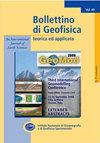Vp/Vs比值在决定线性AVA反演误差传播、稳定性和分辨率中的重要性:一个理论论证
IF 0.7
4区 地球科学
Q4 GEOCHEMISTRY & GEOPHYSICS
引用次数: 14
摘要
线性振幅与角度(AVA)反演自引入油气行业以来,已成为深部沉积物油气勘探的标准工具。然而,在过去的几十年里,随着海上建设活动的增加,这种方法的应用也扩展到预测超压带和/或评估浅海底层的岩土力学性质。在线性AVA反演所要求的输入参数中,有反射界面上的背景Vp/Vs比,通常假设Vp/Vs比为2。在深部压实沉积物中,该值通常非常接近真实值,但在浅层或超压沉积物中,该值可能严重低估了真实值。尽管如此,背景Vp/Vs比值在AVA反演中的重要性经常被低估,因此我考虑了两种常用的Zoeppritz方程近似来研究它们对线性AVA反演结果的影响:三项Aki和Richards方程和两项Ursenbach和Stewart公式。然后分析这些方程,改变Vp/ Vs值,使用灵敏度分析中常用的工具。结果表明,背景Vp/Vs比值控制了误差从数据到模型空间的传播,并决定了反向参数之间的串扰。此外,Vp/Vs比值的增大会导致AVA反演的稳定性降低,并使反射界面处Vs对比度的估计变差。本文章由计算机程序翻译,如有差异,请以英文原文为准。
The importance of the Vp/Vs ratio in determining the error propagation, the stability and the resolution of linear AVA inversion: A theoretical demonstration
The linear Amplitude-Versus-Angle (AVA) inversion has become a standard tool in deep-sediments hydrocarbon exploration since its introduction in the oil and gas industry. However, in the last decades, with the increase of offshore construction activity, applications of this method have been also extended to predict overpressured zones and/or to evaluate the geotechnical properties of shallow sea bottom layers. Among the input parameters requested by linear AVA inversion there is the background Vp/Vs ratio across the reflecting interface and a Vp/Vs ratio of two is frequently assumed. This value is usually very close to the true ratio in case of deep, compacted sediments but it can be a gross underestimation of the true value in case of shallow or overpressured sediments. Despite that, the importance of the background Vp/Vs ratio in AVA inversion is frequently underrated and thus I consider two frequently used approximations of the Zoeppritz equations to study their impact on the outcomes of linear AVA inversion: the three-term Aki and Richards equation and the two-term Ursenbach and Stewart formula. These equations are then analysed, varying the Vp/ Vs value, using tools frequently applied in sensitivity analysis. It turns out that the background Vp/Vs ratio controls the error propagation from data to model space and determines the cross-talk between the inverted parameters. Moreover, an increasing Vp/Vs ratio causes a decrease of stability of the AVA inversion and worsens the estimate of the Vs contrast at the reflecting interface.
求助全文
通过发布文献求助,成功后即可免费获取论文全文。
去求助
来源期刊

Bollettino Di Geofisica Teorica Ed Applicata
地学-地球化学与地球物理
自引率
0.00%
发文量
0
审稿时长
>12 weeks
期刊介绍:
The "Bollettino di Geofisica Teorica ed Applicata" is an international open access journal dedicated to the publication of original papers dealing with Deep Earth Geophysics, Near Surface Geophysics, Exploration Geophysics, Borehole Geophysics, Geodynamics and Seismotectonics, Seismology, Engineering Seismology, Geophysical Modelling, Geodesy, Remote Sensing, Seismic and Geodetic Networks, Oceanography, and their application in the fields of Energy, Natural Resources, Environment and Climate, Policies and Regulations, Risk and Security, Technological Development.
 求助内容:
求助内容: 应助结果提醒方式:
应助结果提醒方式:


